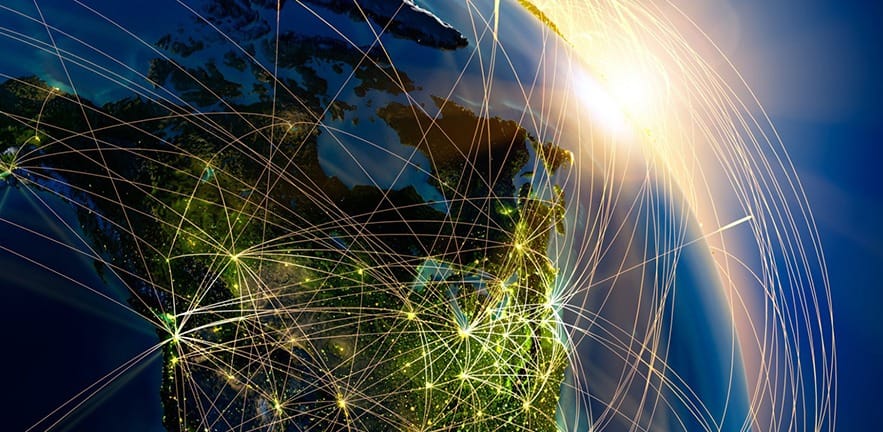Overview
The Centre has compiled a compendium of threat maps, analytics and data layers, as a toolkit for assessing international risk of business disruption.
The Global Risk Index references the classical story of Pandora’s Box of All Ills and is the culmination of a research track that the Centre for Risk Studies has been pursuing since its inception.
This analysis suite consists of a probabilistic event set of over 12,000 catastrophe scenarios representing 22 threats, with potential to cause disruption to economic activity in 279 of the world’s most important cities, responsible for 41% of the world’s GDP.
The consequences of these events are quantified in terms of their ‘GDP@Risk’ – a constant metric that can be used to compare and standardise different types of threat.

Impact of cyber attacks continues to increase across the world
The potential impact of cyber attacks on the economy of the world’s largest cities has risen by nearly 9% in the last year, according to the 2019 update of the Global Risk Index from the Centre for Risk Studies at Cambridge Judge Business School. Cyber risk has now risen from seventh to sixth place among global threats in the index.
Expanding the cyber threat model
Building on years of cyber research the Centre has done, we plan to extend the cyber threat model to individual cyber models that represent real events that can occur within an organisation such as data breaches, cloud outages, extortion, financial theft and DDoS. Research is underway at the Centre to map these exposures to corporate balance sheets and city economies alike.
Additional consequence models
The consequences of the scenarios will be extended from estimating GDP@Risk by adding other types of impacts to the modelling of the events. For insurance use cases this will extend to insurance underwriting loss assessments, derived in terms of index values for different lines of exposure. For international businesses, the consequence modelling will be extended to revenue loss and other operational impact metrics resulting from the scenarios, as needed to support the use case applications.
Trillion dollar scenarios
Tail events are being explored by identifying all threat events with the potential to cause a loss to the global economy of a trillion dollars or more. The universe of trillion dollar events will continue to be developed to characterise the frequency and characteristics of the distribution of extreme potential shock events.
Adding contagion and cascades
The analytical framework will be extended to incorporate contagion of shocks through the global economy, to improve the representation of impacts of localised events elsewhere in the world. The analysis will also explore the potential for one shock event to trigger other shock events in a cascade of consequences.
Real-time event interpretation
As part of our catastrophe scenario research, we are compiling historical case study precedents and calibrating models of likely consequences of unfolding events. We propose to explore the application of these techniques for businesses to respond to potentially threatening current events, by providing interpretation and analysis of the implication of events for various business activities.
| Date | Event |
|---|---|
| 4 Dec 2018 | Cambridge Global Risk Index 2019: Launch Event Find out more |
| 6 Jun 2018 | Lloyd’s City Risk Index 2018 Launch Find out more |
| 6 Dec 2017 | Cambridge Global Risk Index 2017 Find out more |
| 6 Oct 2015 | Lloyd’s City Risk Index – Methodology and Usage of City Economy Risk AnalysisFind out more |
| 3 Sep 2015 | Lloyd’s City Risk Index 2015-2025 Find out more |
The annual updates of the Cambridge Global Risk Indices receive wide coverage from a variety of media channels such as the Financial Times, New York Times, CNBC, Forbes, CNN, Reuters, Sunday Telegraph, US News & World Reports, MarketWatch, Japan Times, Insurance Journal, The Insurance Insider and numerous other news outlets and online platforms. The 2018 Reuters article was syndicated and picked up by 22 different outlets including The New York Times, while 97 regional publications reviewed the index. Further the 2018 Index was mentioned on three live broadcasts: CNBC, CNN and CNBC Europe.
The Telegraph | 23 June 2018
Man-made disasters are now a much greater threat than natural ones
Man-made risks, such as market crash and cyber-attacks, now account for 60% of the total economic output at risk in major cities globally, says a report by the Centre for Risk Studies at Cambridge Judge Business School. The Lloyds’ City Risk Index tracked 279 around the globe and shows a 16% increase in GDP@Risk from last year. (subscription)
Reinsurance News | 7 June 2018
Global economic output at risk from man-made events
Man-made risks, such as market crash and cyber-attacks, now account for 60% of the total economic output at risk in major cities globally, says a report by the Centre for Risk Studies at Cambridge Judge Business School. The Lloyd’s City Risk Index tracked 279 cities around the globe and shows a 16% increase in GDP@Risk from last year. Professor Daniel Ralph, Director of the Centre for Risk Studies, said: “Lloyd’s City Risk Index helps governments, businesses and the insurance sector understand the economic implications of a variety of man-made and natural risks.”
CNBC | 6 June 2018
Cybercrime the fastest developing risk globally
Lloyd’s Chairman Bruce Carnegie-Brown discusses the findings of Global City Risk Index, produced in collaboration with the Centre for Risk Studies at Cambridge Judge Business School. According to the report, the potential impact of geopolitical and security shocks to the economy of the world’s largest cities has risen by 16 per cent in the last year. The index compiled the impact of 22 types of threats, such as market crash, cyber-attack or earthquake, into a single annual measurement of economic loss for 279 world cities.
Asia Insurance Post | 6 June 2018
Report: Threats from conflict and terrorism account for more than half of Indian cities’ risks
The potential impact of geopolitical and security shocks on the economy of the world’s largest cities has risen by 16% in the last year, according to the 2018 Global Risk Index by the Centre for Risk Studies at the Cambridge Judge Business School. The Centre sees a uniform rise in GDP@Risk across all the 279 world cities that make up the index and more significant increases in risk for some urban centres. Five Indian cities including Mumbai, Delhi and Bangalore are in the top 10 globally for civil conflict and terrorism risks.
Forbes | 6 June 2018
Coming soon to a city near you – $320 billion in economic losses
Man-made risks, such as market crash and cyber-attacks, now account for 60% of the total economic output at risk in major cities globally, says a report by the Centre for Risk Studies at Cambridge Judge Business School. The Lloyd’s City Risk Index tracked 279 cities around the globe and showed a 16% increase in GDP@Risk from last year.
Reuters | 6 June 2018
Tokyo is world city facing greatest risks
According to the latest Lloyd’s City Risk Index, Tokyo is facing most risks globally to its annual economic output, due to its proximity to North Korea. The report by the Centre for Risk Studies at Cambridge Judge Business School tracked 279 around the globe and shows a 16 per cent increase in GDP@Risk from last year.








